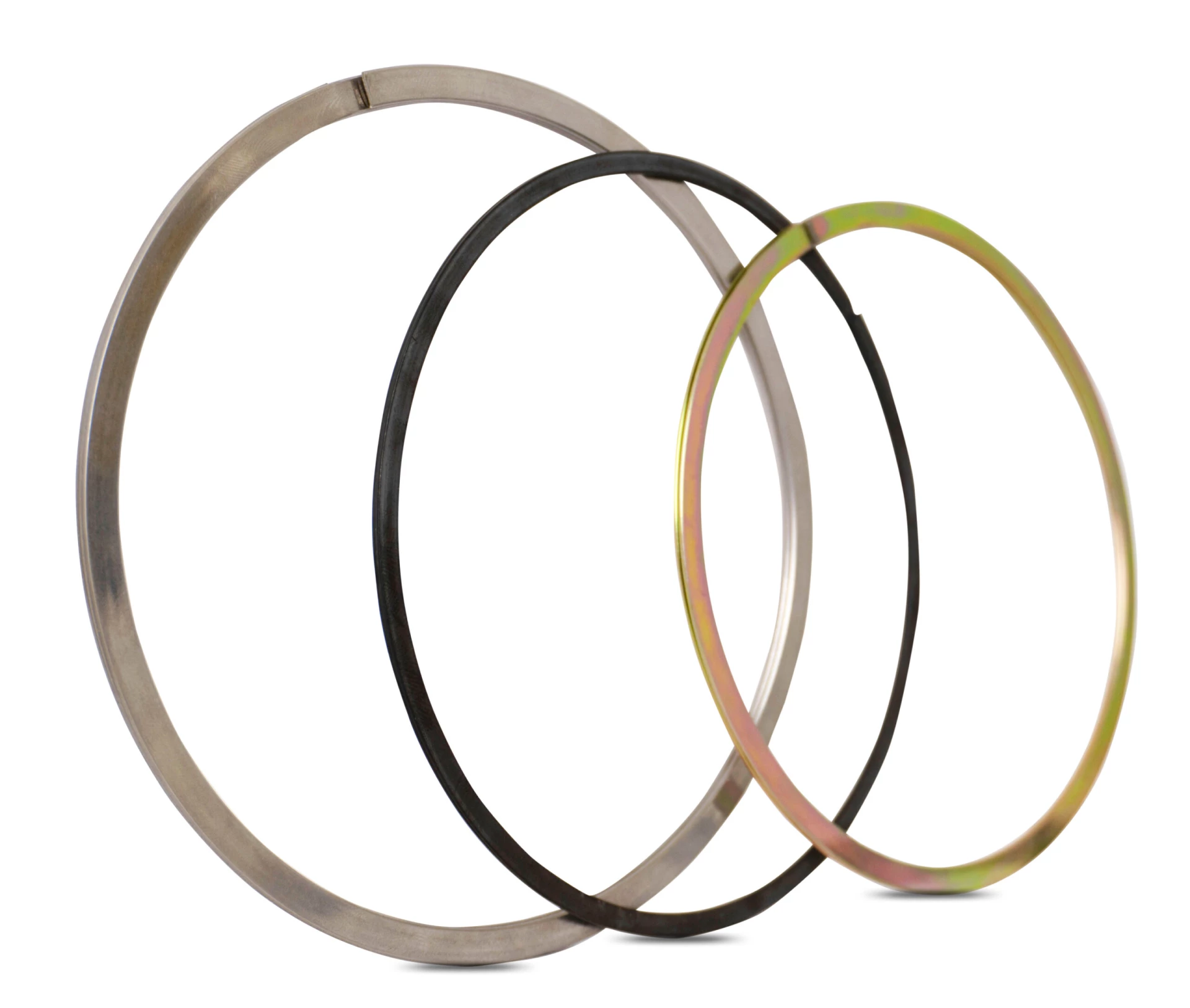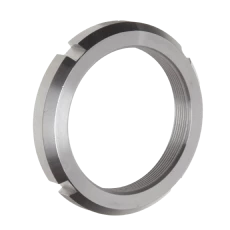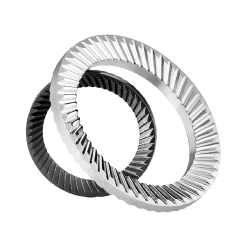GRW Bearings Reduction in radial clearance
High precision ball bearings in grades up to ABEC 9 with bores from 1 to 30mm and comparable inch dimensions
General Information
REDUCTION IN RADIAL CLEARANCE
Reduction in radial clearance due to heat
The ball bearing radial clearance relates to an ambient temperature of 20oC and excludes external loads with exception of the measuring load. Frictional heat to be dissipated or a temperature difference between rotor and stator have the effect of a temperature difference between the inner and outer ring.
The differential expansion between inner ring and outer ring may lead to a reduction in radial clearance which should be taken into consideration in the set-up of the ball bearing:
RV = Δda – Δdi
| RV = | Radial clearance reduction (µm) | |
| Δda = | Diameter change on outer ring between the temperature t and the ambient temperature of 20oC (µm) | |
| Δdi = | Diameter change on inner ring between the temperature t and the ambient temperature of 20oC (µm) |
The diameter change caused by the temperature difference is calculated
For the outer ring: Δda–d0a.α.Δt
and
For the inner ring: Δdi–d0i.α.Δt
| d0a = | Raceway diameter on outer ring at 20oC (µm) | |
| d0i = | Raceway diameter on inner ring at 20oC (µm) | |
| α = | Length expansion coefficient [K-1], For 100Cr6 … 11.0 . 10-6 K-1 For X65Cr13 … 10.5 . 10-6 K-1 | |
| Δ = | Temperature difference between the temperature t and the ambient temperature 20oC (K) |
Example:
Bearing SS6000 GPR j (d – 1mm, D – 26mm, Dw = 4,763mm) reaches an inner ring temperature of 60oC and an outer ring temperature of 30oC during operation. The following raceway diameters are set due to heat expansion.
Outer ring:
| d0a ≈ | (d+D)/2 + Dw ≈ (10+26)mm/2 + 4,763mm ≈ 22,763mm | |
| Δda = | d0a . α . Δt | |
| Δda = | (22,763 . 103) µm . 10.5 x 10-6 K-1 . 10 K = 2.4µm |
Inner ring:
| d0i ≈ | (d+D)/2 + Dw ≈ (10+26)mm/2 + 4,763mm ≈ 13,237mm | |
| Δdi = | d0i . α . Δt | |
| Δdi = | (13,237 . 103) µm . 10.5 x 10-6 K-1 . 40 K = 5.6µm |
Reduction in radial clearance:
RV = Δda – Δdi
RV = 2.4µm – 5.6µm = 3.2µm
This gives a radial clearance reduction of 3.2µm. Our rough estimation does not take into consideration the influence of the balls which would only effect the result slightly.
If the result is positive, an increase in radial clearance should be considered.
Reduction in radial clearance due to irference fit
When selecting the fitting tolerances, you should note that an interference fit causes a reduction in radial clearance. This depends on the effective interference kit and also on the ring thickness ratio and may be calculated very simply.
RV = k . Ü
| RV= | Radial clearance reduction (µm) | |
| Ü= | Largest fitting sizes (µm) | |
| k= | Factor from table 14 whereby it is presumed that the inner ring is pressed onto a compete shaft or the outer ring is pressed into a stable, practically non-deformable housing |
If there is an interference fit on both the shaft and housing, both values should be added to give the complete radial clearance reduction.
Example:
Ball bearing 623 P5 GPR Y is fitted on the shaft with a press fit and with a transition fit in the housing. This results in the following interference kit:
| Bore | +0 / -5µm } = 9µm | |
| Shaft | +4 / -2µm } | |
| Outer diameter | +0 / -5µm } = 6µm | |
| Housing diameter | +0 / -2µm } |
Taking the relevant k value for 623 from table 14 the following radial clearance reduction is achieved:
For the inner ring: RV=k.Ü–0.5.9µm=4.5µm
and
For the outer ring: RV=k.Ü–0.8.6µm=4.8µm
Thus a total maximum radial clearance reduction of 9.3µm results. This must be taken into consideration when selectin the radial clearance of a bearing.
Table 14: k-factor for inner ring (IR) and outer ring (OR)
Basic Type | IR | OR | Basic Type | IR | OR | Basic Type | IR | OR |
681 | 0.6 | 0.8 | 695 | 0.6 | 0.8 | 1016 | 0.6 | 0.8 |
691 | 0.5 | 0.8 | 605 | 0.6 | 0.8 | 1191 | 0.6 | 0.8 |
68/1.5 | 0.6 | 0.8 | 625 | 0.6 | 0.8 | 1397 | 0.6 | 0.8 |
69/1.5 | 0.5 | 0.8 | 635 | 0.5 | 0.8 | 5/64 | 0.6 | 0.7 |
682 | 0.7 | 0.8 | 686 | 0.7 | 0.8 | 2380 | 0.8 | 0.9 |
692 | 0.6 | 0.8 | 696 | 0.7 | 0.8 | 3/32 | 0.5 | 0.9 |
67/2.35 | 0.8 | 0.8 | 626 | 0.6 | 0.8 | 3175 | 0.8 | 0.9 |
68/2.35 | 0.8 | 0.9 | 687 | 0.8 | 0.8 | 1/8A | 0.7 | 0.9 |
68/2.5 | 0.7 | 0.8 | 697 | 0.7 | 0.8 | 1/8B | 0.6 | 0.8 |
69/2.5 | 0.6 | 0.8 | 607 | 0.7 | 0.8 | 3967 | 0.7 | 0.9 |
60/2.5 | 0.6 | 0.7 | 627 | 0.6 | 0.8 | 4763A | 0.9 | 0.9 |
673 | 0.8 | 0.9 | 688A | 0.9 | 0.8 | 4763B | 0.8 | 0.9 |
683 | 0.7 | 0.8 | 688 | 0.8 | 0.9 | 3/16 | 0.6 | 0.8 |
693 | 0.7 | 0.9 | 698 | 0.7 | 0.8 | 6350A | 0.9 | 0.9 |
623 | 0.5 | 0.8 | 608 | 0.7 | 0.8 | 6350B | 0.8 | 0.9 |
674 | 0.8 | 0.9 | 689 | 0.8 | 0.9 | 1/4A | 0.7 | 0.8 |
684 | 0.8 | 0.8 | 699 | 0.7 | 0.8 | 1/4 | 0.6 | 0.8 |
694 | 0.7 | 0.7 | 609 | 0.6 | 0.8 | 7938 | 0.8 | 0.9 |
604 | 0.6 | 0.8 | 629 | 0.6 | 0.8 | 3/8 | 0.7 | 0.8 |
624 | 0.6 | 0.8 | 6800 | 0.8 | 0.9 | |||
634 | 0.5 | 0.8 | 6900 | 0.7 | 0.8 | |||
675 | 0.9 | 0.9 | 6000 | 0.7 | 0.8 | |||
685 | 0.8 | 0.8 |






































